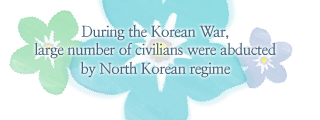Name: admin
2014-01-14 10:12:03 | Hit 1408
Release of Korean War Abduction Sourcebook Vol.2, which includes vivid testimonies of the abductees' families
Oct. 9, 2009
Chosun Daily
"A young North Korean soldier said, "Let’s go outside for a minute.” He left and my father followed him out. My mother bowed low to the ground before the young soldier, who looked to be about only 17 or so, begging him not to take my father.”
The above is the testimony of the novelist Lee Kwang-soo’s second daughter, Lee Jeong-hwa (73), on how he was abducted by the North from his own house in Seoul on July 12, 1950.
She also testified that the North Korean Army attempted to win him over several times when he was imprisoned in Seodaemun Prison, but he refused, and when she went to the prison after the recapture of Seoul on Sept. 28, he had already been transferred to Pyongyang the previous July.
Ms. Lee’s testimony is included in KWAFU’s Korean War Abduction Sourcebook Vol.2 (1,192 pages in total) published on the 8th, along with 69 testimonies from other abductees’ family members. KWAFU, founded by the family members of five abductees in November 2000 during the Kim Dae-jung administration, has played a leading role in addressing issues related to Korean War abductees.
It has made progress on what even the government would not do: it discovered relevant documents on the abductees and urged the international community to pay more attention to the issue. It also published the first volume of Korean War Abduction Sourcebook in 2006 and now it has released the second volume.
▲ The Korean War Abductee's Family Union, or KWAFU, hold a press conference on the 8th on the occasion of the publication of Korean War Abduction Sourcebook Vol.2. From the right, KWAFU Operation Committee Member Choe Gwang-seok, KWAFU President Lee Mi-il, KWAFU Research Director Kim Mi-yoeng. / Yonhap News
The testimonies in Korean War Abduction Sourcebook Vol.2 include evidence that North Korea abducted intellectuals by a premeditated plan. It also portrays Korea’s tragic history of being divided into two and the sufferings of the abductees’ families.
In the sourcebook, the family of An Chan-su, who worked as a reporter for Chosun Daily and later as chief editor of Yonhap Newspaper, testified about his abduction. His wife Kim Ok-myeong (93) and daughter An Byeong-suk (72) said, “After he was abducted, people called my family the family of a reactionary.
They came to our house and took everything we had. All that remained after their rampage were ten spoons and few rice bowls. They also put a red ticket that read ‘state-owned property’ on the front door. They even marked a line on the pots filled with soybean paste and soy sauce and said, ‘You cannot eat more than this much.’”
Han Yeong-suk (61), daughter of Han Chi-jin who was a prominent intellectual and a professor at Seoul National University, testified, “At that time, about 120 relatives lived with my family in our house. Some of them who were intelligent enough to attend Seoul National University became Communists.
They led the search for and abduction of my father who was in hiding.” Mrs. Han’s son, Hwang Gyu-pil (78), a grandson of Han Chi-jin, explained that Gu Ja-ok, the former Governor of Gyeonggi province, was abducted by armed officials from the North Korean Political Security Bureau.
Korean War Abduction Sourcebook Vol.2 also includes historical materials related to the abductees that have been newly discovered by KWAFU. In particular, the List of Displaced Civilians Vol.1, published in January 1963 by the Korean Delegation of the UN Command Military Armistice Commission, is the result of more than three years of research by the government.
The List of Displaced Civilians consists of two volumes, and the first one includes the name, age, sex, and address of 11,700 abductees.
The second volume, however, has not been found yet. KWAFU believes that Vol.2 could include information about some 10,000 more abductees, making the number of names listed more than 20,000 in total.
President of KWAFU Ms. Lee said, “We compared the List of Displaced Civilians Vol.1 with a list made in 1954 by the Public Security Bureau of the Ministry of Home Affairs, which has a similar number of names listed, and found that 30% of the names on the list are new.”
The sourcebook also includes a telegram from the Director for North East Asia at the U.S. State Department to the Assistance Secretary for the Far East Region dated Dec. 11, 1951. It says that the armistice negotiations should not be delayed due to the issue of repatriation of South Korean civilians abducted by the North.
KWAFU sees this as a proof that the repatriation of Korean War abductees was given up for political purpose. The Association, therefore, has a plan to ask the U.S. Congress to pass a resolution acknowledging the past mistake.





















 FAX : (82)31-930-6099
FAX : (82)31-930-6099
